- The diagrams below are graphs of Force in
kiloNewtons versus time in milliseconds for the motion of a 5-kg block moving
to the right at 4.0 m/s.
(a) What is the magnitude and direction of the impulse
acting on the block in each case?
(b) What is the magnitude and direction of the average force
acting on the block in each case?
(c) What is the magnitude and direction of the final velocity
of the block in each case?

- Impulse is given by the area under the F-t curves. Since
we have simple shapes, it is easy to find the area. For rectangles area is
height × base and for triangles area is
half the height × base.
- I = 3 kN × 3 ms = 9 N-s
- I = −1 kN × 6 ms = −6 N-s
- I = 2 kN × 2 ms + ½(−4 kN) × 2 ms = 0 N-s
- I = ½(4 kN) × 4 ms = 8 N-s
If the impulse is positive, the net area was above the curve
and it is directed to the right, if negative to the left.
- We know I = FaveΔt where Δt
is how long the collision lasts. We read Δt
from the graphs, so Fave = I/Δt.
- Fave = (9 N-s)/(3 ms) = 3000 N
- Fave = (−6 N-s)/(6 ms) = -1000 N
- Fave = (0 N-s)/(4 ms) = 0 N
- Fave = (8 N-s)/(4 ms) = 2000 N
If the average force is positive it is directed to the
right, if negative to the left. The impulse and force have the same direction.
- Impulse is also equal to the difference in momentum, I
= mvf − mvi. We can rearrange our equation
for vf, vf = I/m + vi.
- vf = (9 N-s)/(5.0 kg) + 4 m/s = 5.8 m/s
- vf = (?6 N-s)/(5.0 kg) + 4 m/s = 2.8 m/s
- vf = (0 N-s)/(5.0 kg) + 4 m/s = 4 m/s
- vf = (8 N-s)/(5.0 kg) + 4 m/s = 5.6 m/s
![[Return to Top of Page]](./../../top.gif)
- The diagrams below are the velocity versus time graphs for
the collision of motion of a 4-kg block with a wall. The collision lasts for 20
milliseconds in each case.
(a) What is the magnitude and direction of the impulse
acting on the block in each case?
(b) What is the magnitude and direction of the average force
acting on the block in each case?

- Impulse is also equal to the difference in momentum, I
= mvf − mvi. We have the mass, m = 4 kg.
- I = (4 kg) × (−6 m/s − 6 m/s) = −48 N-s
- I = (4 kg) × (2 m/s − 8 m/s) = −24 N-s
- I = (4 kg) × (6 m/s − 0 m/s) = +24 N-s
If the impulse is positive it is directed to the right, if
negative to the left.
- We know I = FaveΔt where Δt
is how long the collision lasts. We have already calculated I and we are given Δt = 20 ms, so Fave = I/Δt.
- Fave = (−48 N-s)/(20 ms) = −2400 N
- Fave = (−24 N-s)/(20 ms) = −1200 N
- Fave = (+24 N-s)/(20 ms) = +1200 N
![[Return to Top of Page]](./../../top.gif)
- You've been rowdy and obnoxious in a bar and are now in the
process of being thrown out by the scruff of the neck by the bouncer.
The bouncer has hold of you for 5.0 s and you are take from a
seated position to a final speed of 2.75 m/s. If your mass is
70.0 kg, what was your final momentum? What impulse and average
force did the bouncer exert on your person? Assume all motion
is in a straight line.
Momentum is defined by p = mv.
Taking the direction of motion as positive, your initial momentum
was zero and your final momentum is
p = (70.0 kg)(2.75 m/s) = 192.5 kg-m/s .
Impulse is defined as the change in momentum
I = pf
- pi = 192.5 kg-m/s .
Average force is related to impulse by I
= FaverageΔt, so
Faverage = I / Δt
= 192.5 kg-m/s / 5 s = 38.5 N .
This is the average force exerted on you and is in
the same direction as your motion.
![[Return to Top of Page]](./../../top.gif)
- A ball of mass 0.500 kg with speed 15.0 m/s collides with a
wall and bounces back with a speed of 10.5 m/s. If the motion
is in a straight line, calculate the initial and final momenta
and impulse. If the ball exerted an average force of 1000 N on
the wall, how long did the collision last?
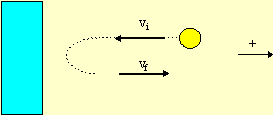
Momentum is defined by p = mv.
Taking the right as positive, the initial momentum of the ball is
pi = (0.5 kg)(-15 m/s) = -7.5 kg-m/s .
The final momentum is
pf = (0.5 kg)(10.5 m/s) = 5.25 kg-m/s .
Impulse is defined as the change in momentum
I = pf
- pi = 12.75 kg-m/s .
Average force is related to impulse by I
= FaverageΔt,
and the wall would exert this force on the ball to the right. Therefore
Δt = I / Faverage
= 12.75 kg-m/s / +1000 = 0.013 s.
The ball is in contact with the wall for approximately
13 milliseconds.
![[Return to Top of Page]](./../../top.gif)
- A ball of mass 0.25 kg glances of a wall as shown in the
diagram. The ball approaches at 15 m/s at θ
= 30° and leaves at 12 m/s at φ = 20°. The
collision lasts for 15 milliseconds.
(a) What are the components of the impulse experienced by
the ball?
(b) What are the components of the average force acting on
the ball?

- We know Impulse is equal to the difference in momentum, I
= mvf − vi. This is a vector equation and
to get components we consider the x and y components separately.
Ix = mvfx − mvix = (0.25) × (12cos20° − 15cos30°) = −0.4285 N-s
Iy = mvfy − mviy = (0.25) × (12sin20° − (−15sin30°)) = +2.9011 N-s
or I = −i0.4285 + j2.9011
N-s.
- We know I = FaveΔt where Δt
is how long the collision lasts. We have already calculated I and we are given Δt = 15 ms, so Fave = I/Δt
so Fave = (−i0.4285 + j2.9011
N-s) / (15 ms) = −i28.6 + j193.4 N.
![[Return to Top of Page]](./../../top.gif)
- Explain why a person wearing a seatbelt in a car accident
is less likely to be seriously hurt than the person who isn't
wearing a seatbelt.
Wearing a seatbelt would not effect the person's
initial and final momentum. Since impulse is the change in momentum,
the impulse experienced by the person would be the same in either
case. However, it is not impulse which is dangerous but the magnitude
of the forces acting on the person's body. Impulse and average
force are related by I = Faverage
Δt. For the same impulse, the average force
will be higher as the collision time Δt
decreases. Cars are designed to crumple on impact.
This crumpling is designed to make a collision last as long as
possible. If a person is wearing a seatbelt, the time for the
person's change in momentum is the same as that of the car thereby
minimizing the force on the occupant. If the person is not wearing
a seatbelt, the Law of Inertia dictates that the person will keep
moving forward (Note some people describe this by saying that
the person was thrown forward by the force of impact. Why is this
wrong?). This means that the person will impact the steering wheel
or windshield. The steering wheel and windshield can't collapse
as nicely as the front of the car so Δt
is much smaller and thus the average force is much higher.
![[Return to Top of Page]](./../../top.gif)
- A lion of mass 120 kg leaps at a hunter with a horizontal velocity
of 12m/s. The hunter has an automatic rifle firing bullets of
mass 15 g with a muzzle speed of 630m/s and he attempts to stop
the lion in midair. How many bullets would the hunter have to
fire into the lion to stop its horizontal motion? Assume the bullets
stick inside the lion.
The total momentum of the system, the bullets and
the lion, would be zero since there are no external forces to
consider,
P = mlionvlion
- nmbulletvbullet = 0 ,
where the lion is assumed to be moving in the positive
direction. Rearranging the equation to find n,
n = mlionvlion / mbulletvbullet
= (120 kg 12 m/s) / (0.015kg 630 m/s) = 152.4 .
It would take 153 bullets to stop the lion dead,
so to speak.
![[Return to Top of Page]](./../../top.gif)
- On a frictionless surface, a 6.0-kg rock approaches from the
left at 3.5 m/s. It collides with a 9.0-kg rock which
is approaching from the right at 1.7 m/s. They stick to one another after the
collision. Determine the magnitude
and direction of their velocity after the collision. Ignore the
effects of friction. How much
kinetic energy is lost in the collision?
In any kind of collision, momentum is conserved so
m1v1f + m2v2f
= m1v1i + m2v2i .
We are told that the collision is perfectly elastic
which means that kinetic energy is not conserved and that the
rocks stick together, v1f = v2f = vf.
Our equation becomes
(m1 + m2)vf
= m1v1i + m2v2i .
This allows us to find vf immediately
vf = [m1v1i
+ m2v2i]/(m1 + m2)
= [6 kg×3.5 m/s + 9 kg×(-1.7 m/s)]/ 15 kg = 0.38 m/s .
Notice that this is the same as the velocity of the
Centre of Mass.
The initial kinetic energy is
Ki = ½m1(v1i)2
+ ½m2(v2i)2 = ½(6)(3.5)2
+ ½(9)(-1.7)2 = 49.755 J .
The final energy is
Kf = ½(m1 + m2)(vf)2
= ½(6+9)(0.38)2 = 1.083 J .
The difference in energy is
ΔK = Kf - Ki
= -48.7 J .
![[Return to Top of Page]](./../../top.gif)
- A 50.0-kg skater is traveling due east at 3.00 m/s. A 70.0-kg
skater is moving due south at 7.00 m/s. They collide and hold
on to one another after the collision. Determine the magnitude
and direction of their velocity after the collision. Ignore the
effects of friction.
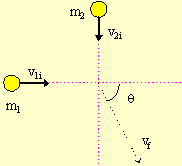
In any kind of collision, momentum is conserved so
(m1 + m2)vf
= m1v1i + m2v2i
.
(1)
Now momentum and velocity are vector quantities and
the i and j components must be handled
separately
(m1 + m2)vfx
= m1v1ix + m2v2ix ,
(1a)
(m1 + m2)vfy
= m1v1iy + m2v2iy .
(1b)
So we can rearrange these equations to find the components
of the final velocity
vfx = (m1v1ix
+ m2v2ix) / (m1 + m2) ,
(2a)
vfy = (m1v1iy
+ m2v2iy) / (m1 + m2) .
(2b)
Using the given values, we find
vfx = [(50 kg)(3 m/s) + (70 kg)(0)]
/ (50 kg + 70kg) = 1.25 m/s ,
(2a)
vfy = [(50 kg)(0) + (70 kg)(-7 m/s) / (50 kg + 70 kg)
= 4.083 m/s .
(2b)
To find the magnitude and direction of the final
velocity, we use Pythagoras' Theorem and trigonometry,
vf = [(vfx)2
+ (vfx)2]½ = 4.27 m/s, and
θ = tan-1
(|vfy/vfx|) = 72.98°.
The final velocity of the pair is 4.27 m/s at 73.0° south of east.
![[Return to Top of Page]](./../../top.gif)
- Football player A tackles and holds onto player B in the diagram below.
(a) Assuming friction is negligible, what is the velocity of the players just after the collision?
(b) If the collision lasts for 0.30 seconds, what average force (magnitude and direction) does player A exert on player B?
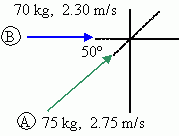
In any kind of free collision, momentum is conserved so
(mA + mB)vf
= mAvAi + mBvBi
.
(1)
Now momentum and velocity are vector quantities and
the i and j components must be handled
separately
(mA + mB)vfx
= mAvAix + mBvBix ,
(1a)
(mA + mB)vfy
= mAvAiy + mBvBiy .
(1b)
So we can rearrange these equations to find the components
of the final velocity
vfx = (mAvAix
+ mBvBix) / (mA + mB) ,
(2a)
vfy = (mAvAiy
+ mBvBiy) / (mA + mB) .
(2b)
Using the given values, we find
vfx = [(75 kg)(2.75 m/s)cos(50°) + (70 kg)(2.30 m/s)]
/ (75 kg + 70kg) = 2.025 m/s ,
(2a)
vfy = [(75 kg)(2.75 m/s)sin(50°) + (70 kg)(0) / (75 kg + 70 kg)
= 1.090 m/s .
(2b)
To find the magnitude and direction of the final
velocity, we use Pythagoras' Theorem and trigonometry,
vf = [(vfx)2
+ (vfx)2]½ = 2.30 m/s, and
θ = tan-1
(|vfy/vfx|) = 28.3°.
The final velocity of the pair is 2.30 m/s at 28.3° above horizontal.
The force on player B has to do with the impulse acting on him and his change of momentum,
Faverage = IB/Δt
(3)
Now force and impulse are vector quantities and
the i and j components must be handled
separately.
Fave x = (mBvBfx - mBvBix)/Δt ,
(3a)
Fave y = (mbvBfy - mBvBiy)/Δt .
(3b)
Using the given values, we find
Fave x = (70 kg)[(2.025 m/s) - (2.30 m/s)]
/ (0.30 s) = -64.17 N ,
(4a)
Fave y = (70 kg)[(1.090 m/s) - (0)]
/ (0.30 s) = 254.33 N .
(4b)
To find the magnitude and direction of the average force, we use Pythagoras' Theorem and trigonometry,
Fave = [(Fx)2
+ (Fy)2]½ = 262 N, and
θ = tan-1
(|Fy/Fx|) = 75.8°.
The average force on player B is 262 N at 94.2° above horizontal.
![[Return to Top of Page]](./../../top.gif)
- A curling rock is traveling down the ice when it mysteriously
explodes into three parts. After the explosion, one piece having
27.0% of the total mass moves at a speed of V1f = 14.2
m/s at an angle of 42.0° to the
positive y axis. A second with 52.0% of the total mass move at
a speed of V2f = 18.9 m/s at an angle of 17.8°
to the positive x axis. The third piece moves with speed V3f
= 35.9 m/s at 39.0° to the negative
y axis. What was the speed of the stone before the explosion?
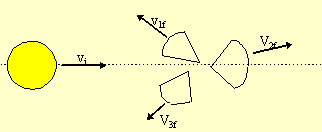
In any kind of collision, momentum is conserved so
m1V1f + m2V
2f + m3V3f = (m1 +
m2 + m3)Vi .
(1)
Now momentum and velocity are vector quantities and
the i and j components must be handled
separately
m1V1fx + m2V2fx +
m3V3fx = (m1 + m2 +
m3)Vix .
(1a)
m1V1fy + m2V2fy +
m3V3fy = (m1 + m2 +
m3)Viy .
(1b)
So we can rearrange these equations to find the components
of the final velocity
Vix = (m1V1fx
+ m2V2fx + m3V3fx)
/ (m1 + m2 + m3) ,
(2a)
Viy = (m1V1fy
+ m2V2fy + m3V3fy)
/ (m1 + m2 + m3) .
(2b)
Taking the masses of the piece to be m1
= 0.27M, m2 = 0.52M, and m3 = (1-0.27-0.52)M
= 0.21M where M is the total mass, and using the given values,
we find
Vix = [0.27(-14.2sin(42°))
+ 0.52(18.9cos(17.8°)) + 0.21(35.9sin(39°))] = 2.05 m/s ,
Viy = [0.27(14.2cos(42°))
+ 0.52(18.9sin(17.8°)) + 0.21(-35.9cos(39°))] = 0.0 m/s .
The stone had an initial speed of 2.05 m/s to the right.
![[Return to Top of Page]](./../../top.gif)
- Two opposing hockey players are racing up the ice for the puck when they collide at point A as shown in the diagram below. The first hockey player has mass 90 kg and a speed of 2.7 m/s while the other has mass 82 kg and speed 3.1 m/s. The angle in the diagram is θ = 32° . After the collision, the players remain locked together (at least until the referee forces them apart). What is the magnitude and direction of the players' velocity just after they collide?

Since the collision is totally inelastic and in two dimensions,
we find that we are dealing with a vector addition problem,
PT = P1 + P2.
First we calculate the magnitude of each player's momentum using
p = mv,
P1 = m1v1 = (90 kg)(2.7
m/s) = 243 kg-m/s ,
P2 = m2v2 = (82 kg)(3.1
m/s) = 254.2 kg-m/s.
Then we find PT by the component method,
| i |
j |
| P1x |
= 0 |
P1y |
= 243 |
| P2x |
= 254.2sin(32°)
= 134.705 |
P2y |
= 254.2cos(32°)
= 215.574 |
| PTx |
= 134.705 |
PTy |
= 458.574 |
Using the Pythagorean formula we find,
PT = [(PTx)2 + (PTy)2]½
= [(134.705)2 + (458.574)2]½
= 477.949 kg-m/s .
Using trigonometry, we find the angle from
θ = arctan(PTy/PTx)
= arctan(458.574/134.705) = 73.63°.
So the total momentum of the two players is PT = (478,73.6°).
Now PT = (m1 + m2)vf,
so the final velocity must be in the same direction as the total
momentum. The magnitude of the velocity is
vf = PT/(m1 + m2)
= 477.949 kg-m/s/ (90 kg + 82 kg) = 2.78 m/s .
So the final velocity of the two players just after the collision
is vf = (2.78 m/s, 73.6°).
![[Return to Top of Page]](./../../top.gif)
- On a frictionless surface, a 6.0-kg rock approaches from the
left at 3.5 m/s. It collides elastically with a 9.0-kg rock which
is approaching from the right at 1.7 m/s. Find the final velocities of the rocks.
We are dealing with a collision, so we know we
must conserve momentum,
m1v1f + m2v2f
= m1v1i + m2v2i .
(1)
We are told that the collision is elastic which means
that kinetic energy is conserved. For a 1D collision, this is
the same as
v2f - v1f = -(v2i
- v1i) .
(2)
Substituting in the give data, our equations become
6v1f + 9v2f = 6×3.5
+ 9×(-1.7) = 5.7 ,
v2f - v1f = -(-1.7
- 3.5) = 5.2 .
Solving the two equations in two unknowns, we find
v1f = -2.74 m/s and v2f = 2.46 m/s.
![[Return to Top of Page]](./../../top.gif)
- In a pool game, balls of the same mass undergo elastic collisions.
Suppose the white ball collides with a stationary 8-ball off-centre.
After the collision, both balls travel at an angle to the original
velocity of the white ball as shown in the diagram. If the initial
speed of the white ball is v and θ
= 30.0°, determine φ
and the speeds of the balls.
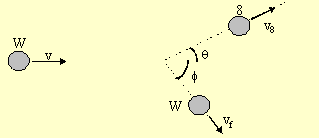
In any kind of collision, momentum is conserved so
mWvf + m8v8
= mWv .
(1)
Now momentum and velocity are vector quantities and
the i and j components must be handled
separately
mWvfx + m8v8x
= mWvx ,
(1a)
mWvfy + m8v8y
= mWvy .
(1b)
Since this is an elastic collision, kinetic energy
is conserved and we have
½mW(vf)2
+ ½m8(v8)2 = ½mWv2 .
(2)
Since billiard balls have the same mass mW
= m8 = m, can be eliminated from the equations above.
The equations become
vfcosφ
+ v8cosθ = v ,
(3a)
-vfsinφ
+ v8sinθ = 0 ,
(3b)
(vf)2 + (v8)2
= v2 .
(3c)
Now cos(30°) = (√3)/2 and
sin(30°) = ½. Thus equation (3b) yields
v8 = 2vfsinφ .
(4)
Using this result to eliminate v8 from
(3a) and (3c), we get
v = vf[(√3)
sinφ + cosφ] .
(5a)
v2 = (vf)2[1 +
4sin2φ] .
(5b)
We put the expression for v from (5a) into (5b) and get
[(√3)sinφ
+ cosφ]2 = [1
+ 4sin2φ] .
Expanding the square on the left-hand side
3sin2φ
+ (2√3)sinφ
cosφ
+ cos2φ
= 1 + 4sin2φ .
Rearranging, this becomes
(2√3)sinφ
cosφ
= 1 + sin2φ
- cos2φ .
Recall that cos2φ
= 1 - sin2φ , so
that the right-hand side simplifies and we get
(2√3)sinφ
cosφ
= 2sin2φ .
Eliminating common terms, we get
(√3)cosφ
= sinφ .
Recall that tanφ
= sinφ/cosφ,
so that the above is actually tanφ
= √3. This yields
φ = 60°.
With this result we can go back to equation (4) and
find that
v8 = (√3)vf .
Using the result for φ and equation (5a)
we get
v = 2vf .
Thus v8 = (√3)v/2 .
![[Return to Top of Page]](./../../top.gif)
![[Return to Physics Homepage]](./../../physics.gif)
![[Return to Mike Coombes' Homepage]](./../../coombes.gif)
![[Return to List of Handouts]](./../../handouts.gif)
![[Return to Problem Sets]](./../../problems.gif)
![[Return to List of Solutions]](./../../solutions.gif)









![[Return to Physics Homepage]](./../../physics.gif)
![[Return to Mike Coombes' Homepage]](./../../coombes.gif)
![[Return to List of Handouts]](./../../handouts.gif)
![[Return to Problem Sets]](./../../problems.gif)
![[Return to List of Solutions]](./../../solutions.gif)